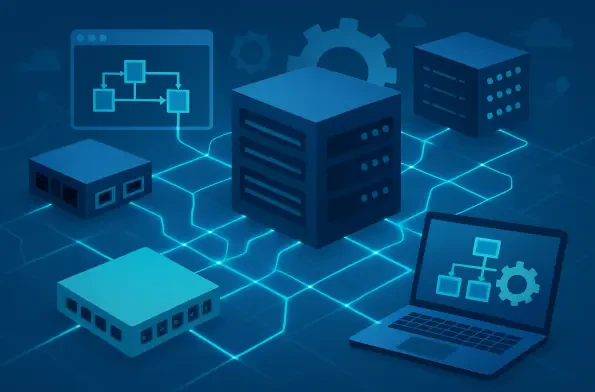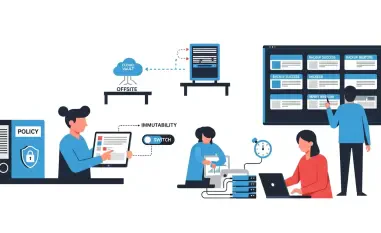In an era where digital transformation dictates the pace of business, the networking landscape is experiencing a seismic shift driven by automation and programmability, fundamentally altering how organizations connect their people, applications, and data. Once reliant on painstaking manual configurations, networks are now evolving into dynamic, software-defined systems capable of adapting in real time to ever-changing demands. This revolution promises not only enhanced agility but also the potential to streamline operations on an unprecedented scale. However, with such innovation comes a complex web of challenges—ranging from technical hurdles to cultural resistance—that must be addressed to fully realize the benefits. As the final piece in a comprehensive series exploring modern networking trends, this discussion delves into the pivotal role automation plays in reshaping connectivity. Insights from industry experts shed light on the tools, skills, and strategies that are paving the way for a future where networks are not just infrastructure, but intelligent, responsive ecosystems.
Building Networks with Code: The Rise of Infrastructure as Code
The concept of Infrastructure as Code (IaC) stands at the forefront of networking’s automated future, offering a method to provision and manage resources through code rather than manual intervention. Already a staple in cloud computing, IaC is slowly making inroads into networking, promising speed and consistency that traditional methods struggle to match. Yet, its adoption remains uneven, particularly outside cloud-centric environments where traditional networks are less dynamic. A significant barrier lies in the hesitation to trust automated systems, with many organizations wary of potential downtime and disruptions. Industry perspectives point to the integration of legacy systems as another stumbling block, often requiring complex workarounds to align with modern practices. Despite these challenges, IaC is gaining traction for tasks like compliance audits and quick remediation, demonstrating its potential to transform network management into a more agile and repeatable process.
To overcome skepticism surrounding IaC, experts emphasize the importance of implementing robust safety mechanisms to build confidence among network teams. Strategies such as pre-release code scanning, testing in non-production environments, and employing blue/green deployment models are recommended to minimize risks. These safeguards ensure that errors can be caught and corrected before they impact live systems, addressing concerns about reliability. Furthermore, the agility offered by IaC allows organizations to respond swiftly to business needs, whether scaling resources or enforcing security policies through automated scripts. As more teams witness successful deployments with minimal disruptions, the reluctance to adopt IaC is expected to diminish. This gradual shift underscores a broader trend: the need to balance innovation with resilience, ensuring that automation enhances rather than jeopardizes network stability. The journey toward widespread IaC adoption in networking may be slow, but its promise of efficiency continues to drive interest and experimentation across the industry.
Navigating Automated Networks: The Evolution of Observability
As automation takes hold of networking, the role of observability becomes increasingly critical, evolving from simple monitoring to a sophisticated form of intelligence that guides decision-making. Unlike traditional tools that merely report on network status, modern observability seeks to uncover the root causes of issues and propose actionable solutions, acting as a compass for automated environments. Businesses now demand tools that offer clear, advisory insights—features like security scorecards and automated remediation are becoming standard expectations. Real-time telemetry plays a vital role in this context, validating changes made by automated systems and ensuring they align with intended outcomes. This transition reflects a broader need for networks to not only react to problems but anticipate and prevent them, leveraging data to maintain seamless operations in an increasingly complex digital landscape.
However, the flood of data generated by automated networks poses a significant challenge, often overwhelming teams with information that lacks coherence or context. Turning this raw data into meaningful insights requires standardization, with frameworks like YANG and OpenTelemetry emerging as solutions to unify fragmented telemetry. By creating consistent data formats, these standards help transform noise into clarity, enabling observability tools to deliver precise guidance rather than vague alerts. This shift is crucial for maintaining control in fast-paced, automated settings where delays in understanding issues can lead to cascading failures. Moreover, as observability tools become more predictive, they empower organizations to address potential vulnerabilities before they escalate. The evolution from passive monitoring to proactive intelligence marks a turning point for networking, ensuring that automation is not just about speed but also about informed, strategic management of resources.
Transforming Talent: The Skill Shift in Network Operations
Automation’s impact on networking extends beyond technology, fundamentally altering the skill sets required of network operations (NetOps) professionals in a software-driven era. Historically rooted in command-line interface (CLI) expertise, network engineers now face pressure to adapt to coding and automation practices, a transition that many find daunting due to fears of losing control over manual processes. Resistance to this change is palpable, yet the industry agrees that embracing new skills is essential for staying relevant. A practical starting point lies in learning accessible programming languages like Python, which can demystify automation scripts and ease the shift away from traditional methods. This incremental approach acknowledges the cultural challenges while providing a pathway for engineers to build confidence in managing networks through code.
Beyond basic coding, familiarity with broader IT practices such as DevOps methodologies and continuous integration/continuous deployment (CI/CD) models is becoming indispensable for NetOps teams. These concepts, once peripheral to networking, now play a central role in aligning network management with agile software development cycles. Additionally, certifications and training programs are being updated to prioritize automation, cloud integration, and software skills over memorization of specific commands. This educational evolution aims to equip professionals with the tools to design and oversee intelligent, responsive networks rather than merely maintaining static systems. While the learning curve is steep, the shift represents an opportunity to redefine the role of network engineers as strategic contributors to business goals. Adapting to this new reality ensures that talent remains a cornerstone of innovation, driving the successful implementation of automated networking solutions.
Balancing Innovation: Open Standards Versus Vendor Ecosystems
A pivotal question in the automation of networking is whether the industry will coalesce around open standards or fragment into proprietary vendor ecosystems, each with its own set of tools and protocols. On one hand, customers increasingly demand open standards to avoid being locked into a single provider, seeking flexibility to mix and match solutions as needed. On the other hand, vendors often push beyond these standards to offer unique features that differentiate their products, creating ecosystems that prioritize ease of use over interoperability. This tension poses a dilemma for organizations, particularly in multi-cloud and hybrid environments where inconsistent tools and policies across providers complicate automation efforts. Navigating this landscape requires careful consideration of trade-offs between the simplicity of vendor-specific solutions and the complexity of maintaining open, interoperable systems.
To address these challenges, abstraction tools like Terraform are gaining attention for their ability to bridge disparate ecosystems, enabling a degree of interoperability that mitigates vendor lock-in risks. However, the reality of multi-cloud settings remains intricate, as differing approaches to automation across platforms can lead to fragmented management practices. Experts caution that while proprietary ecosystems may offer streamlined experiences, they often come at the cost of long-term flexibility, potentially stifling innovation. Conversely, adhering to open standards demands greater effort in integration but fosters a more adaptable infrastructure. As automation continues to redefine networking, striking a balance between these competing forces will be crucial. Organizations must weigh immediate operational needs against future scalability, ensuring that their choices today do not limit their ability to evolve with emerging technologies tomorrow.
Charting the Path Forward: Lessons from Automation’s Impact
Reflecting on the journey of automation in networking, it became evident over time that this shift was not merely a trend but a fundamental redefinition of how connectivity was managed. The adoption of Infrastructure as Code had proven to be a catalyst for agility, even as initial hesitations around trust and legacy integration slowed progress. Observability had matured into a vital tool for intelligence, guiding automated systems with precision once standardization efforts curbed data overload. NetOps teams had grappled with significant skill shifts, gradually embracing coding and DevOps practices despite early resistance, a testament to the power of incremental learning and updated training.
Looking ahead, organizations that had invested in these areas found themselves better positioned to navigate the complexities of a digital landscape. The balance between open standards and vendor ecosystems remained a persistent challenge, yet it spurred a focus on hybrid solutions that combined the best of both worlds. Moving forward, the emphasis must be on fostering resilience through rigorous testing, prioritizing actionable insights over raw data, and continuously upskilling talent to keep pace with technological advancements. These steps, grounded in the lessons of past transitions, offer a blueprint for harnessing automation to build networks that are not only efficient but also adaptable to future demands.













